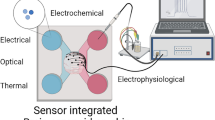Abstract
Objective
To develop a novel chronic intermittent hypoxia chamber for rat models.
Design
The intermittent hypoxia chamber included two animal cabins (28 × 20 × 15 cm) and a hypoxia chamber (80 × 80 × 60 cm) between them, as well as the actuating device. Pure nitrogen was fed into the hypoxia chamber continuously in order to keep the low O2 concentration. Each animal cabin could move in and out of the hypoxia chamber with precise timing function. As a result, the animal cabins could be covered by the hypoxia chamber and got the same low O2 concentration as in the hypoxia chamber and normal O2 concentration as out of the hypoxia chamber. Twelve healthy, male Sprague–Dawley rats (200 ~ 250 g) were selected to test the effect of the intermittent hypoxia chamber. The O2 concentration in the hypoxia chamber was 10 ± 0.5%, and the cycle time of intermittent hypoxia was 180 s (the hypoxia and normoxic time was 90 s, respectively). The hypoxia chamber ran 8 h per day. The arterial blood gas analysis (ABSA) of rats was conducted when the animal cabin was located inside and outside the hypoxia chamber.
Results
The chronic intermittent hypoxia chamber ran safely and reliably. The ABSA showed that the lowest PaO2 was 35.75 ± 4.02 mmHg and the lowest SaO2 was 68.62 ± 8.36% when the animal cabin was covered by the hypoxia chamber.
Conclusions
The chronic intermittent hypoxia chamber designed by us was suitable to establish a chronic intermittent hypoxia model for rats.

Similar content being viewed by others
References
Bao G, Metreveli N, Li R, Taylor A, Fletcher EC (1997) Blood pressure response to chronic episodic hypoxia: role of the sympathetic nervous system. J Appl Physiol 83:95–101
Deegan PC, McNicholas WT (1995) Pathophysiology of obstructive sleep apnoea. Eur Respir J 8:1161–1178
Fagan KA (2001) Selected contribution: pulmonary hypertension in mice following intermittent hypoxia. J Appl Physiol 90:2502–2507
Leuenberger UA, Brubaker D, Quraishi S, Hogeman CS, Imadojemu VA, Gray KS (2005) Effects of intermittent hypoxia on sympathetic activity and blood pressure in humans. Auton Neurosci 121:87–93
Wolk R, Kara T, Somers VK (2003) Sleep-disordered breathing and cardiovascular disease. Circulation 108:9–12
Xu W, Chi L, Row BW, Xu R, Ke Y, Xu B, Luo C, Kheirandish L, Gozal D, Liu R (2004) Increased oxidative stress is associated with chronic intermittent hypoxia-mediated brain cortical neuronal cell apoptosis in a mouse model of sleep apnea. Neuroscience 126:313–323
Fletcher EC, Lesske J, Qian W, Miller CC, Unger T 3d (1992) Repetitive, episodic hypoxia causes diurnal elevation of blood pressure in rats. Hypertension 19:555–561
Greenberg HE, Sica AL, Scharf SM, Ruggiero DA (1999) Expression of c-fos in the rat brainstem after chronic intermittent hypoxia. Brain Res 816:638–645
Lefebvre B, Godin-Ribuot D, Joyeux-Faure M, Caron F, Bessard G, Lévy P, Stanke-Labesque F (2006) Functional assessment of vascular reactivity after chronic intermittent hypoxia in the rat. Respir Physiol Neurobiol 150:278–286
Phillips SA, Olson EB, Lombard JH, Morgan BJ (2006) Chronic intermittent hypoxia alters NE reactivity and mechanics of skeletal muscle resistance arteries. J Appl Physiol 100:1117–1123
Greenberg HE, Sica A, Batson D, Scharf SM (1999) Chronic intermittent hypoxia increases sympathetic responsiveness to hypoxia and hypercapnia. J Appl Physiol 86:298–305
Author information
Authors and Affiliations
Corresponding author
Rights and permissions
About this article
Cite this article
Li, C., Lu, J. & Zhang, B. Development of a novel chronic intermittent hypoxia chamber. Sleep Breath 16, 177–179 (2012). https://doi.org/10.1007/s11325-010-0470-0
Received:
Revised:
Accepted:
Published:
Issue Date:
DOI: https://doi.org/10.1007/s11325-010-0470-0




